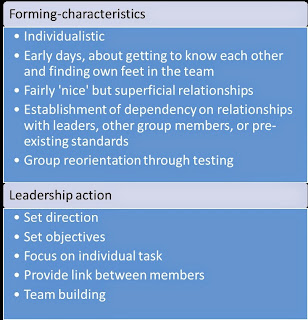My
team is six-months-old! It’s worth celebrating - with some reflections. There
is still a long way to go. I was going through Bruce Tuckman's model of group
development recently (Tuckman 1965), and I pondered on where the team was at this time.
As
a reminder, Tuckman describes a team’s development process and the behaviours
in each stage. A team starts with forming
and progresses to storming, norming and performing. My goal is to
get us to the performing stage as soon as possible.
Definitely,
the first three months were spent in the forming stage. All the team members
had been trying to find their space and understand their roles. People still
had legacy ways of working and behaviours—negative and positive—which had been
carried into the new team. Many of the negative behaviours had to be overlooked
because there was no new team-agreed way of working.
What
have we achieved in the past six months? We have a team vision and team plan
for the coming year starting in April. Each member of the team has an updated
job description, and relationships with key stakeholders are now starting to
form. My leadership style had been more directive during this period because
direction was needed; however gradually, I started using coaching style.
Fortunately
or unfortunately, I think this clarity on roles and responsibilities brought to
the fore anxieties about not having a team-agreed ways of working. The
relationship between members were still full of uncertainty with trust issues on
all sides. This was definitely the
beginning of the storming stage.
At
a meeting, the team members brought up the need to develop standard ways of
working, and I thought this was fantastic. They felt we needed a team event to
discuss how we can work together and start bonding. It was a case of ‘we now
know what we are to do, but how do we do it best as a team?’
I
thought this was a major step in moving quickly through the storming to the
norming stage. I encouraged the team to come up with solutions and to suggest
ideas. The long-term and short-term goals of the team were clearer, but each
person’s contribution was important for its achievement.
We
fast-tracked a team-away day. It was an initial one-day programme acknowledging
that this was the beginning of a process to define and build our team. We
revisited the vision of the organisation and within that, the team's. We did a
strength, weakness, opportunities and threat analysis (SWOT). Based on this, we
developed an action plan to build on our strengths, manage our weaknesses,
maximize our opportunities and turn our threats to opportunities. This action
plan will be reviewed in our monthly meeting to track progress. Yes, and we
will be having a team event every two months to help us continue to bond.
As
a leader, one process that helped me in the past was having a personal coach. We
all need the safe space to brainstorm ideas and express frustration. I promise,
we all need it. If your organisation can't afford a paid coach, get a trusted
and experienced friend to play that role.
In
a new team, your words, actions and behaviour are closely monitored. Some of
your team members will try to test how far they can push you and see what they
can get away with. You may get frustrated, but never show this frustration to
your team; be professional all the way.
Seriously,
this stage is one of the most challenging for a leader, who is focused on
building a high-performing team. As a leader, you will be stretched. Many
times, I have had to put the team first. I am someone who wants to do things right
now, but I have had to be patient and walk at the pace of the team; I have had
to spend time discussing ideas one-on-one to get a team member’s buy-in—no matter
how much I would like to get things done immediately.
At
this stage it is important that the team members feel consulted, included and
informed regarding decisions affecting the team.
Watch
this space for an account of the team moving from storming to norming.


No comments:
Post a Comment